Did you know that up to 70% of projects fail to deliver expected outcomes? Not only do most projects fail, but many also waste about 12% of the project spend due to poor performance. These could have been prevented if there was proper project planning.
A well-crafted project plan is the foundation of any successful project. It provides a roadmap for the entire team and a structured framework that keeps all tasks organized. Through project planning, you can minimize risks, ensure proper coordination, optimize resource utilization, and keep every phase of a project on track. Ultimately, effective project planning would most likely lead to project success.
However, creating a project management plan from scratch can already feel like navigating through a labyrinth. Particularly for those who are new to the task and those handling complex projects, deciding how best to organize, prioritize, and present the various details of your project can be confusing.
The wrong approach to project planning could result in project failure. Using generic templates for complex projects could lead to confusion, budget overruns, and missed deadlines. On the other hand, using advanced software for simple projects bring unnecessary costs and leaning curves.
This is where access to a diverse range of project plan templates become useful. These ready-made frameworks help you detail each aspect of your project to create a roadmap that guides your entire team and shows you how the project is progressing.
Where to get free project plan templates? Right here! Sign up for a Piktochart account and access free customizable templates for different stages of your project planning process.
Top Project Plan Templates to Streamline Your Projects
If your project isn’t that complex, free templates for Excel, Word, or Google Docs may be enough for your needs. There are basic templates to get started on project briefs and advanced ones that include communication plans and work breakdown structure templates. Piktochart also has free customizable templates for different project plan needs. It’s a pretty nifty platform for creating professional-looking visual content, such as project communication and planning documents.
Project Timeline Templates
Have a clear overview of your schedule and identify potential bottlenecks with a graphical representation of your timeline. These templates help you spot possible causes of delays at any part of any project before they happen. You can then adjust your schedule and the task details at that particular point for your project plan to ensure you meet your deliverables on time.
For instance, if you’re a marketing head in charge of launching a new product campaign, you can use a project timeline to make sure you accomplish everything within a tight timeframe. This project involved multiple tasks, including market research, conceptualization, content creation, advertising, and design. The timeline helps keep track of the deadlines for each task so the campaign can be launched on time.
To choose the right one for your project, consider the following factors:
- Project complexity. For simple projects with straightforward task dependencies and a small number of milestones, a basic timeline template like the scatter chart may suffice. Complex projects with multiple interdependent tasks may require advanced features such as critical path highlighting.
- Team size. If your project involves large teams, choose a timeline template that supports real-time collaboration. Cloud-based templates with commenting functionalities would be ideal for your project planning needs.
- Project needs. Choose a project timeline template that aligns with your project requirements. Check if it can accommodate specific features such as milestone tracking, task dependencies, role designations, and other elements unique to your project.
Project Timeline (Excel)
This Excel template uses a scatter chart to give you a quick glimpse of expected deadlines for project milestones and completion. It also shows task dependencies and how they overlap during the entire course of the project.
What’s great about this template is that it’s easy to customize. Simply download the template and edit it in Excel. Change the title, insert your logo, or use your brand colors. Edit the task details and dates, and then share the work plan with other project team members.
Project Timeline Template (Google Sheets)
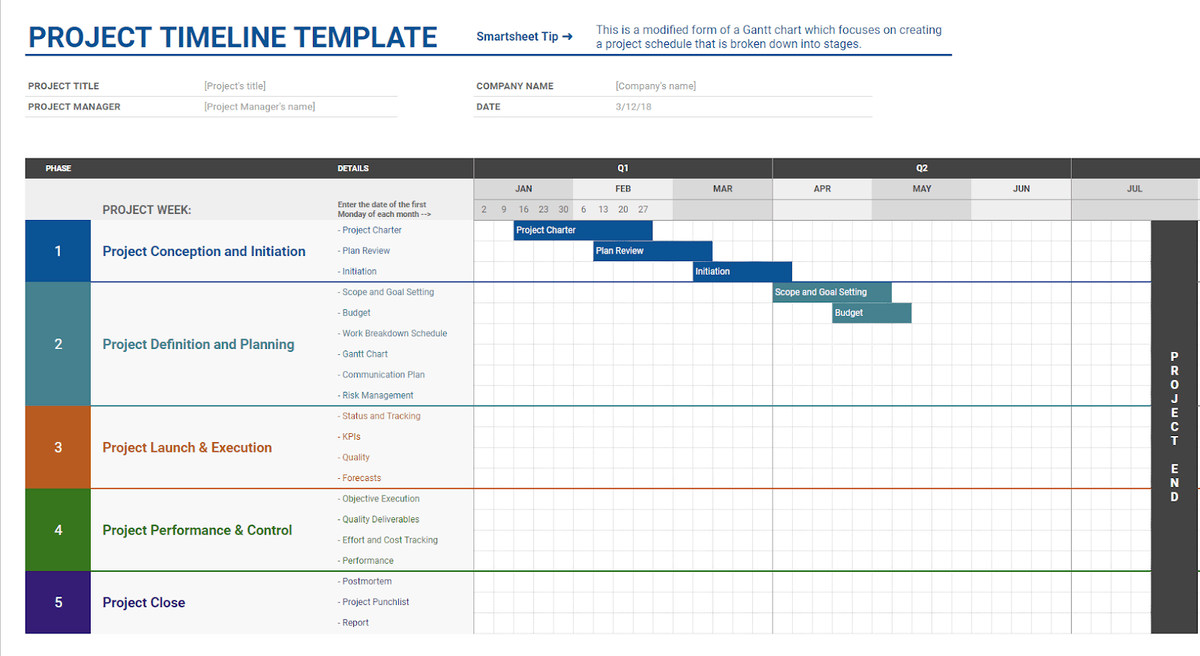
Designed by Smartsheet, this customizable template breaks down your project schedule into phases. Organize every project into stages from planning to completion. Make a concise list of the tasks involved in each stage and set the start and end dates for each one.
Once you’ve set the dates, you’ll be able to view a bar chart of your project timeline. Review the schedule and adjust dates if necessary to ensure you meet the deadline without hitches.
Gantt Project Plan Templates
Gantt chart templates help visualize your project timeline and track progress. Data is organized into rows and columns, and color-coded bar graphs show how much work has already been accomplished. You can define every task involved in the project, the person in charge of the task, and the deliverable due dates. You can also mark task dependencies and milestones to break down complex undertakings into simpler, more manageable phases or sprints. To help team members and stakeholders interpret and utilize the chart, set color codes to highlight critical tasks or priority levels or to visualize task accountabilities.
Let’s say you’re launching a new mobile application. Use the Gantt chart template to create a timeline and assign roles for your software development project. The project could be divided into the following stages: design, development, testing, and deployment. Tasks for each stage can be listed in detail along with the members assigned to each of them. The chart can also show the dependency among development stages and ensure a logical and efficient workflow.
Basic Gantt Project Planner Template (Excel)
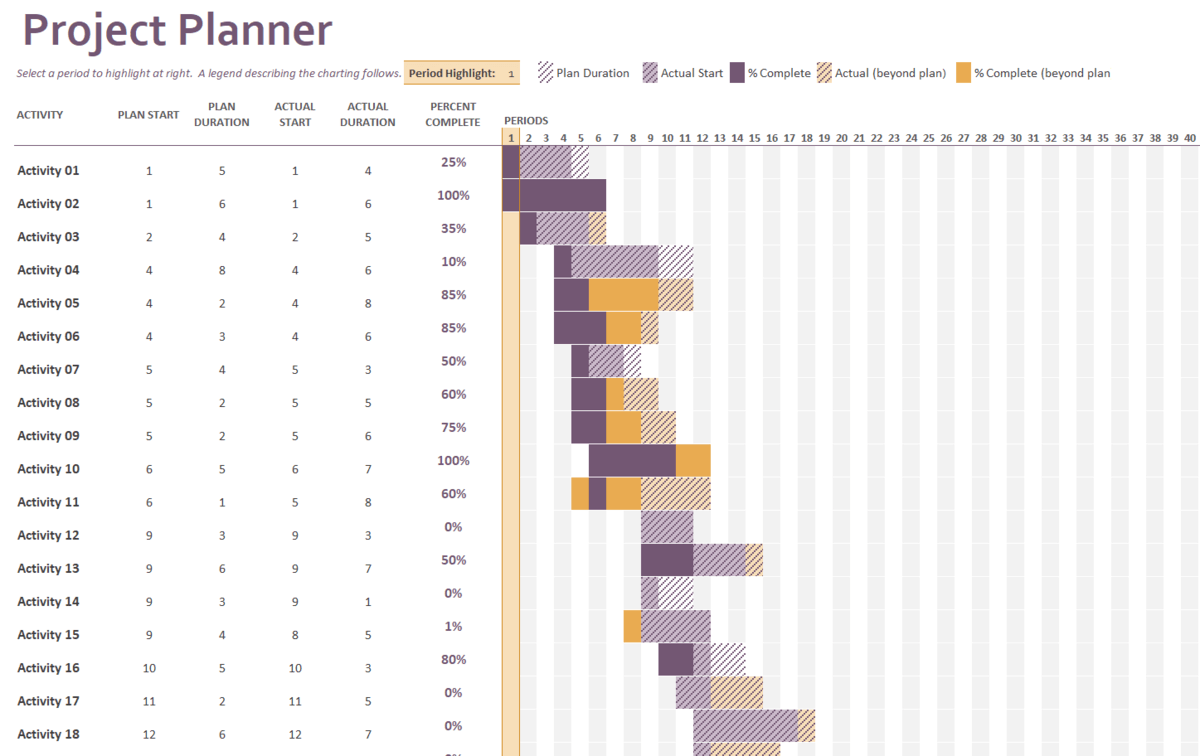
For small projects that do not involve multiple phases, use this simple Gantt chart template to track project performance. Before you start your next project, it gives you an overview of the entire timeline so you can determine how to manage the project over time.
To customize the template, change the title and list down the tasks involved in chronological order from when each one is supposed to start. Then, set the number of days within which a task should be accomplished. The bar graph on the right side will show you which tasks overlap and the progress of each task once the project execution begins.
Agile Gantt Project Plan Template (Excel)
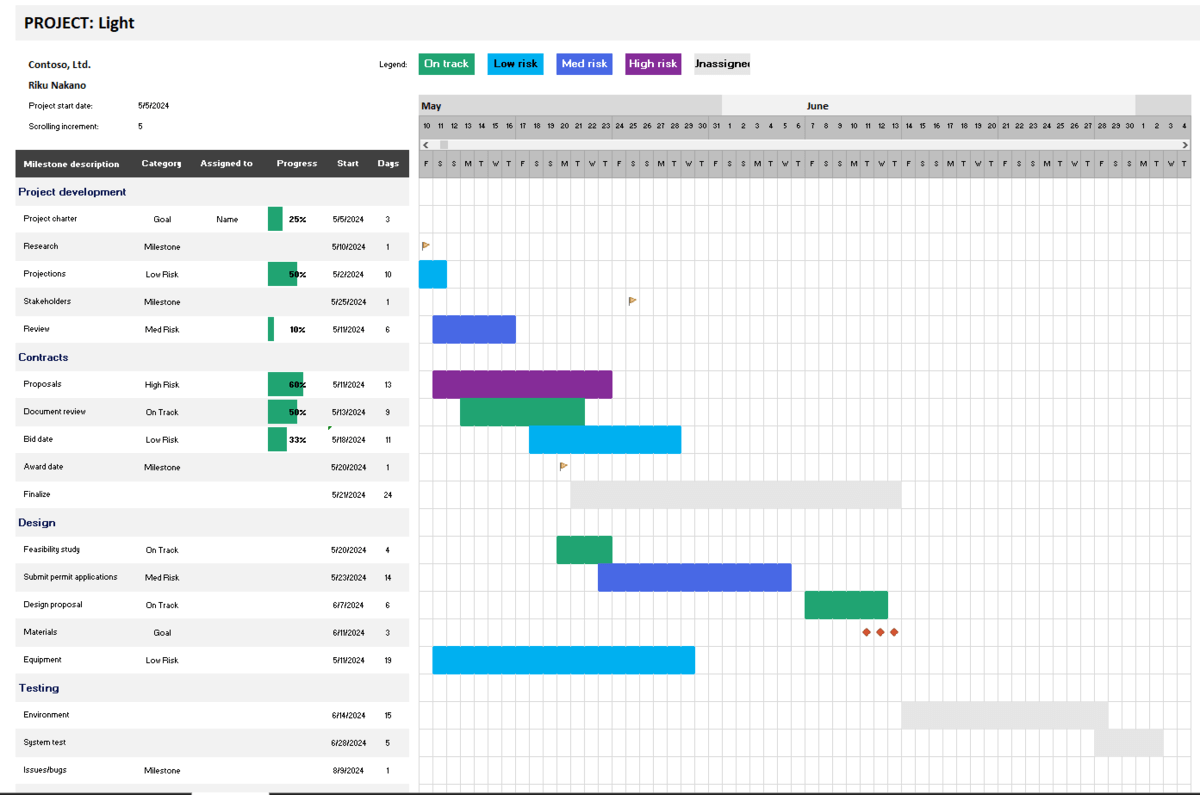
For more complex projects that involve multiple stages and teams, use this Agile Gantt chart template to help visualize each phase of the project. Downloadable and customizable on Excel, it helps organize task assignments and keep track of deadlines. Once the project begins, the progress column shows how much of a task has been completed. Among the things you can do with this template are:
Edit the headings and content to align with your project goals.
Insert new task details or milestones.
Add the start date and the number of days you are allotting to the entire project until its completion.
Set color codes to serve as visual reminders of the progress of each task.
Like most Excel templates, the worksheet automatically updates the data whenever you add or change information on certain fields.
Gantt Chart Template (Google Sheets)
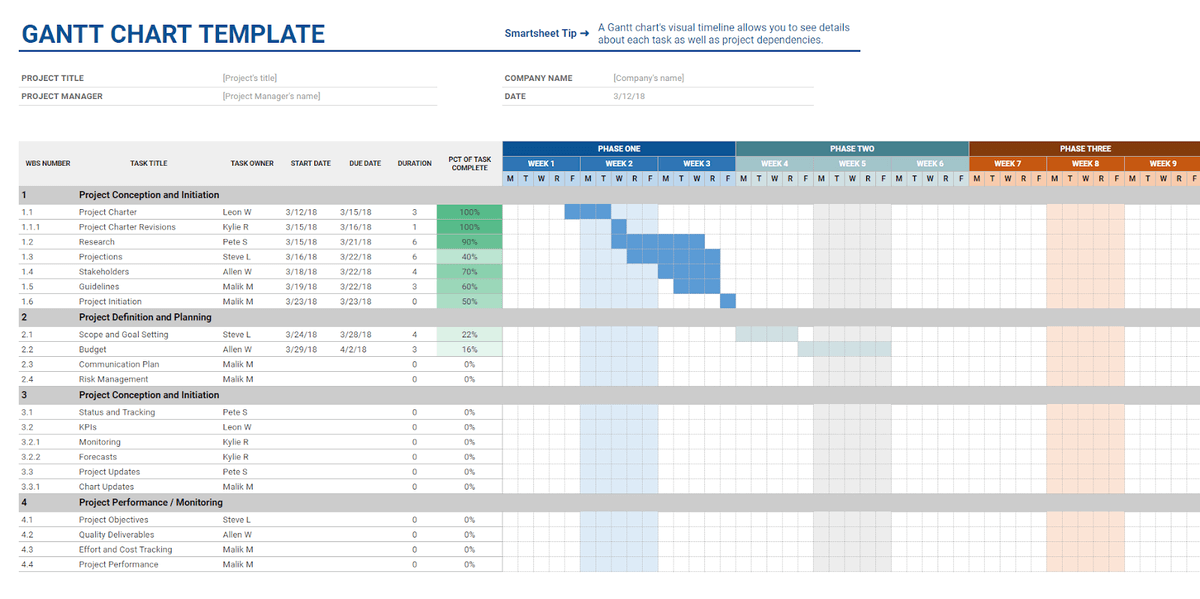
For efficient team collaboration on complex projects, this Gantt chart template on Google Sheets provides convenient access for multiple users. Designed by Smartsheet, this template makes it easy for you to divide your project into phases and assign key individuals to every task.
Use the template to break down your project into sprints and track progress. Assign roles and define responsibilities to ensure accountability once the project is ongoing. Set the start and end dates for each task to view a visual timeline of your project. Once the project begins, monitor progress through the Percent of Task Complete column.
Project Budget Templates
Make sure you stay within your budget with a work plan template that includes resource allocation, cost control, and budget tracking. For example, a budget template for a construction project may show the detailed allocation of funds for labor, building materials, machinery rentals, and subcontractor fees for each construction phase. A marketing team can also use these template types to visualize spending per channel or platform and set budget limits to prevent overspending.
The templates below can be used to estimate costs for each phase and create a realistic budget.
Project budget template (Excel)
This simple action plan template was designed for a home remodeling project but can be easily customized for other simple projects as well. Set budgets for materials, labor, and other overheads and use the pie chart to see how much of the total funds are being allocated to each aspect of the project.
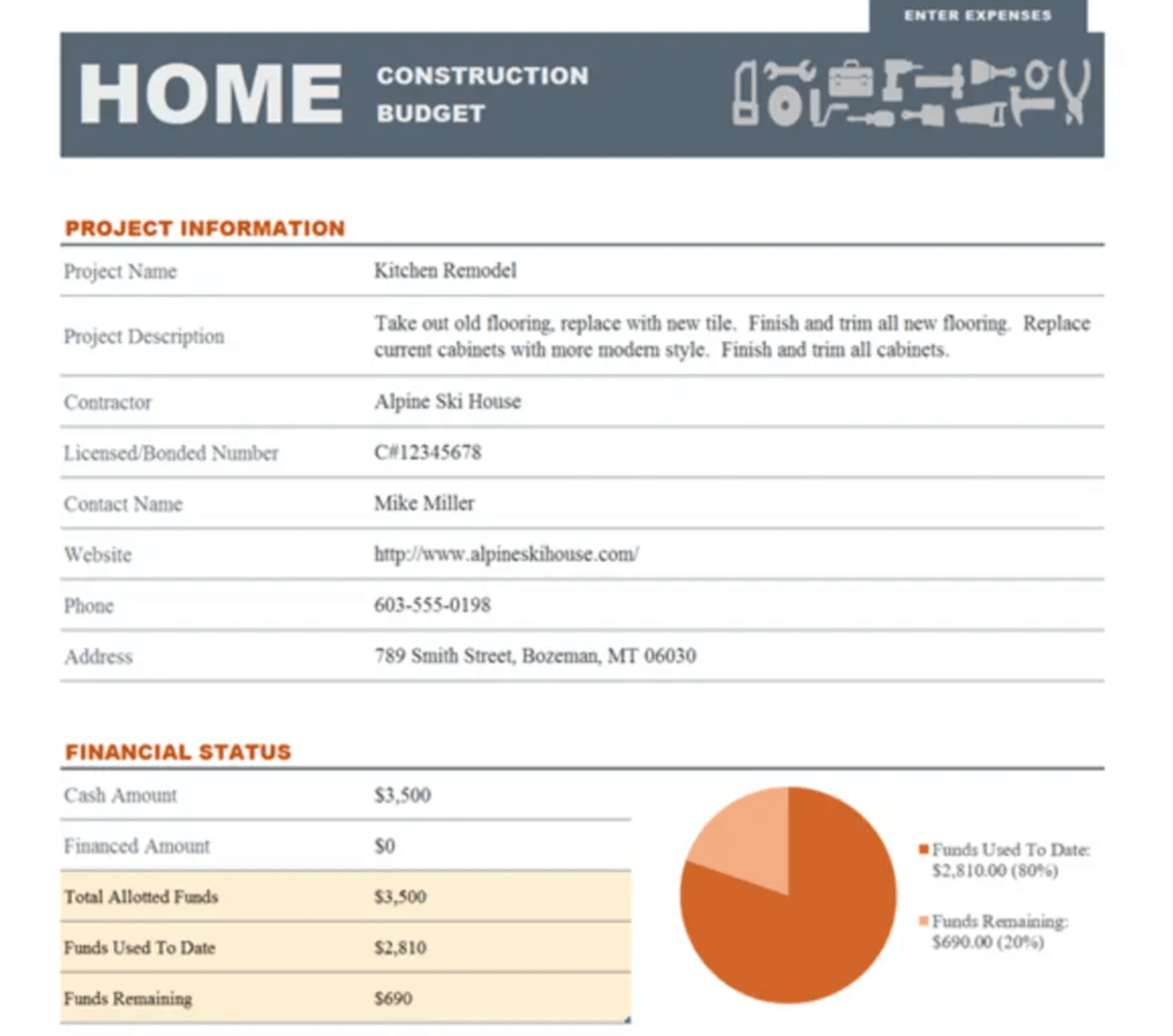
If you’re sharing this with other stakeholders, customize the colors and other design elements so they match your brand image.
Project Status Report (Word)
Need a template for a project brief that includes budget allocation? Check this project plan template for Word. This template can be used to create a project brief, set budgets for different tasks, and assess project risks. Once your project starts, it can also be revised and serve as a status report during each milestone.
This management plan template includes sections for the project summary, a list of tasks with their corresponding due dates, budget allocation and spending for each task, reports of issues, and recommendations. If your project is fairly small and simple, this plan template helps you organize everything without the headaches.
Project Plan Templates from Piktochart
Free templates from Word, Excel, and Google are convenient and easy to use. But, with millions of people also using them, they can appear commonplace. If you need a project plan template with a distinctive design, consider templates from Piktochart. Many of them are also free to customize using advanced editing tools on the Piktochart platform. Piktochart templates can be customized to meet your planning needs, regardless of what industry or sector you’re in.
Marketers and creators can use content calendar templates to visualize their content schedule, plan promotions, or sync social media postings. For those in construction and design, project timeline templates are a great help in scheduling and coordination. Infographic templates also make creating visual safety plans, emergency procedures, and hazard identification charts easy. Software developers and general project managers would find project brief templates and agile sprint board templates useful in project planning and progress tracking.
Most Piktochart templates are free to customize using advanced editing tools on the platform. Here are some unique templates you can use for planning projects.
For projects that require daily check-ins, project planner templates can help keep all team members aligned with the overall goal as they accomplish their daily tasks. Use this project plan template to provide a highly detailed breakdown of daily work schedules. Plan individual schedules a week in advance to make sure each team member finishes their assigned tasks on time.
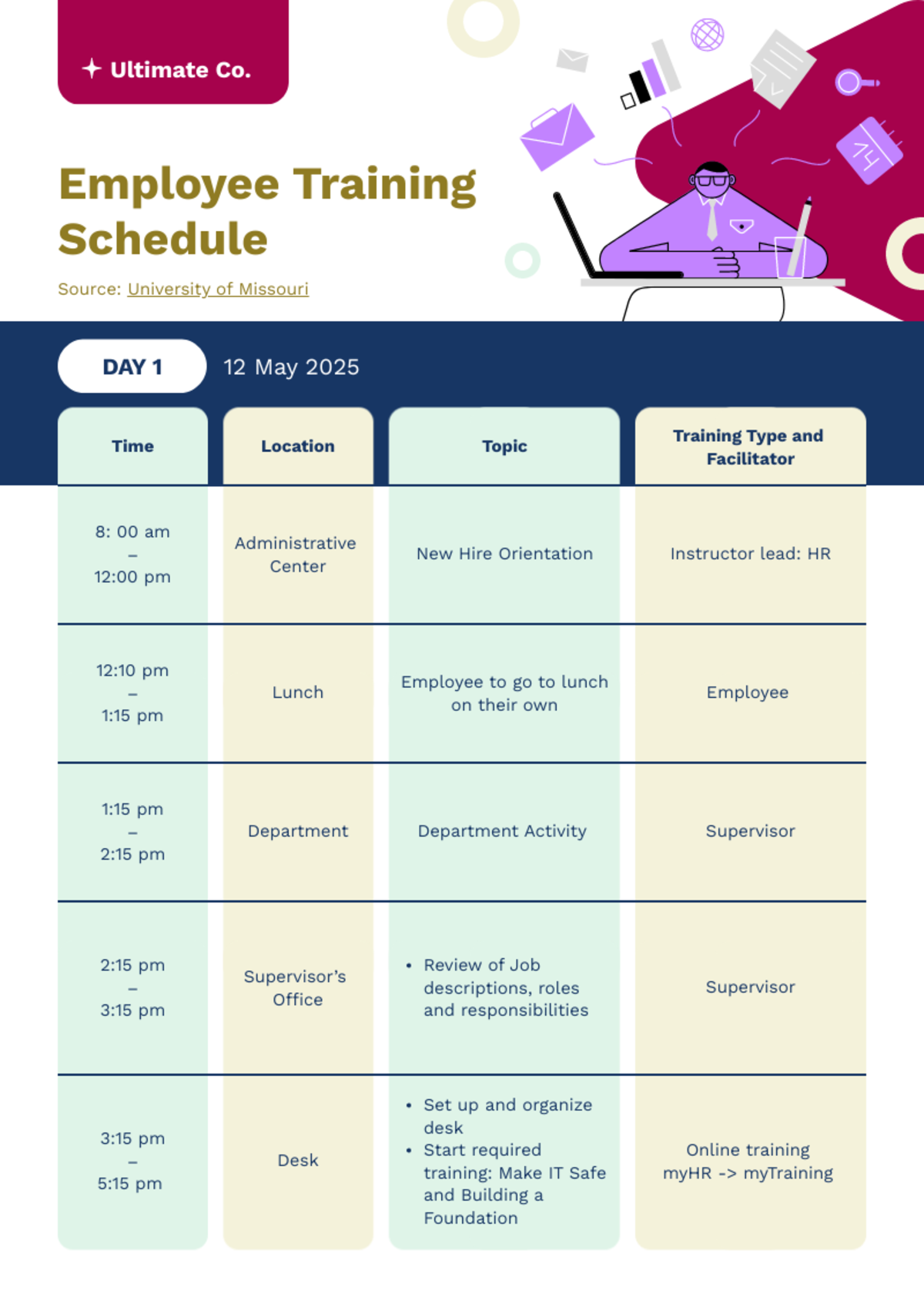
Have each team leader prepare a task list to easily identify who is accountable for each project phase. This template simplifies the task assignment process and monitoring. List the tasks involved in your project according to priority and include the person in charge and the details of the task. Set deadlines and add crucial notes to keep the entire team on track.
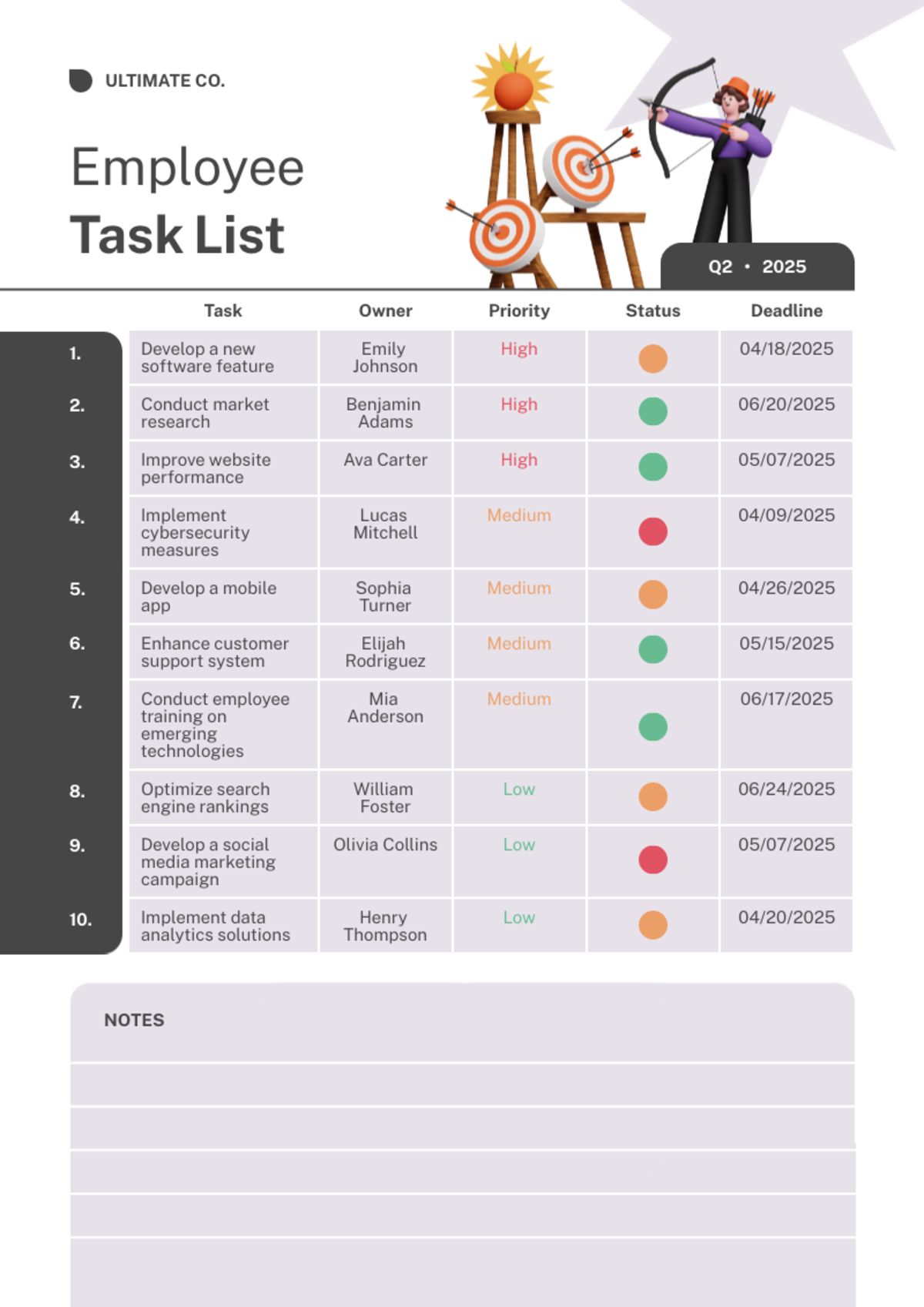
Piktochart has several templates for managing schedules. These can be customized to align with your project type and goals. This template below, for instance, is designed for academic use but can be tailored to project plans. The layout of sections and bulleted lists is ideal for organizing task details, to-do lists, goals, and due dates.
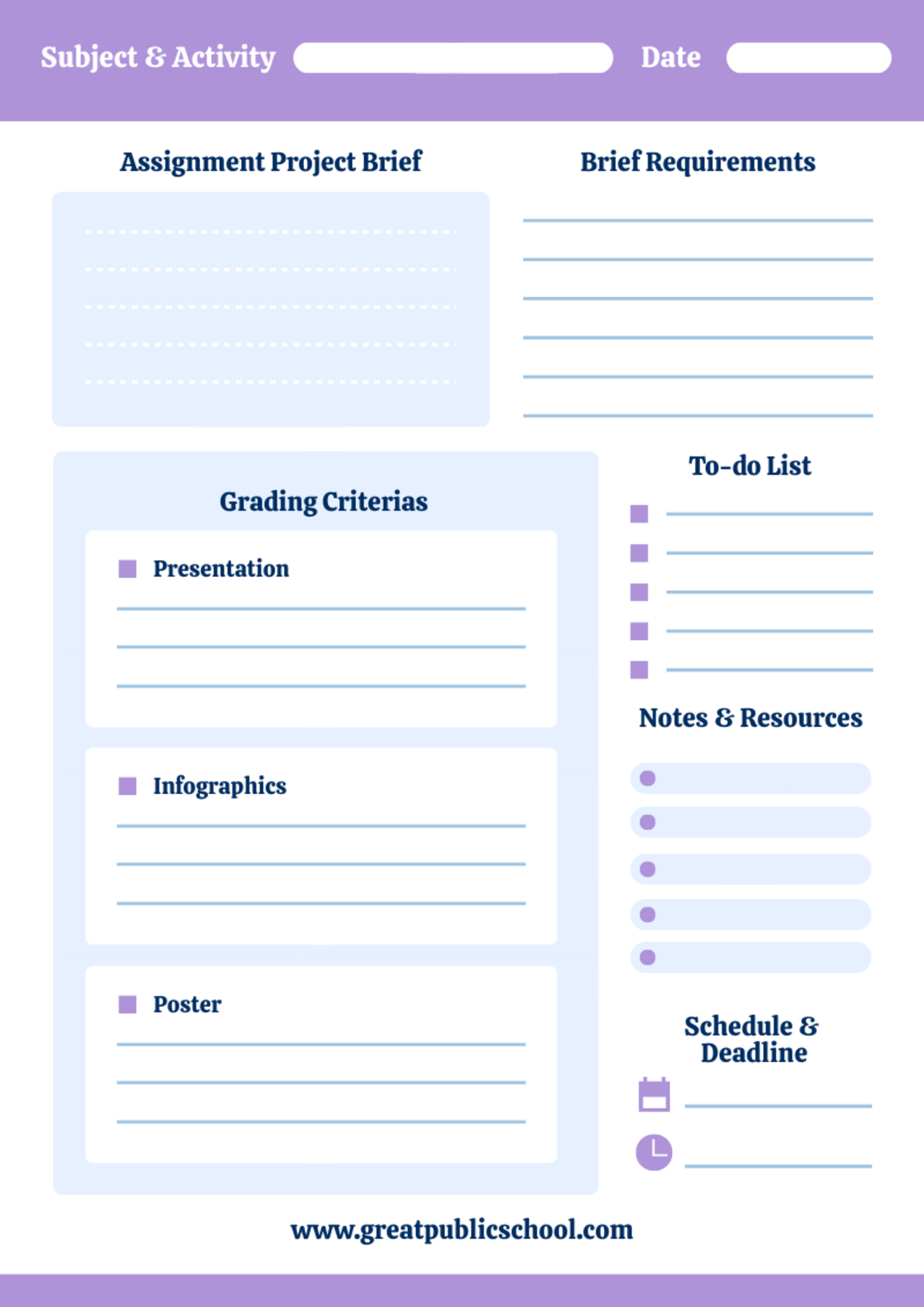
For projects that require training before execution, these templates provide a structured framework for scheduling activities and seeing how they align with the project itself. This project plan template can be a good starting point for your project implementation.
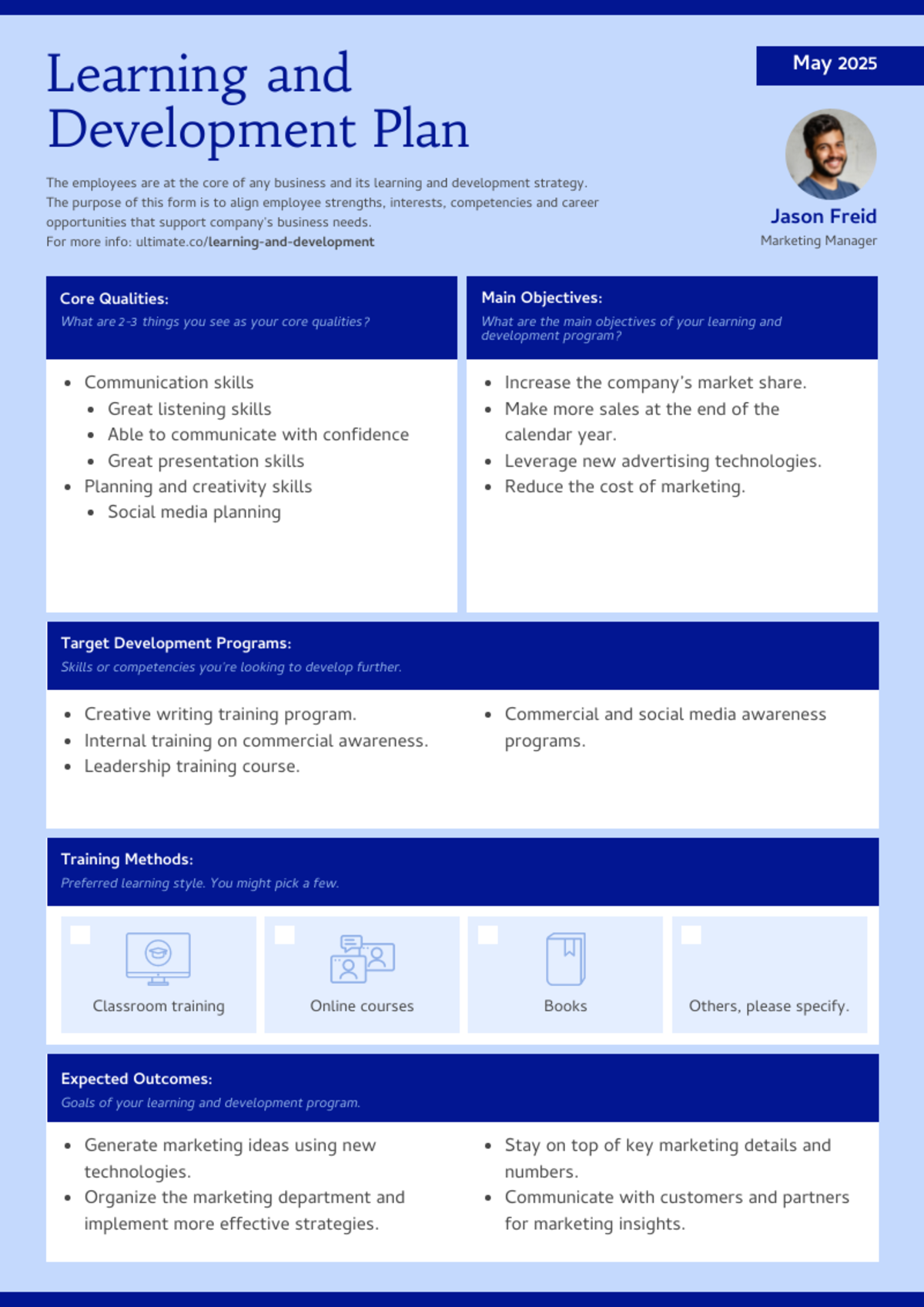
Get every project plan approved with a proposal that captures attention while giving a comprehensive view of the project. This free action plan template is not only visually appealing but also has multiple sections you can use to break down the project scope, objectives, and timeline.
Customize the template with your own images, font styles, and brand colors. Use bulleted lists, text boxes, charts, and tables to organize your information. Present your project in a professional manner and increase your chances of approval and successful project execution.
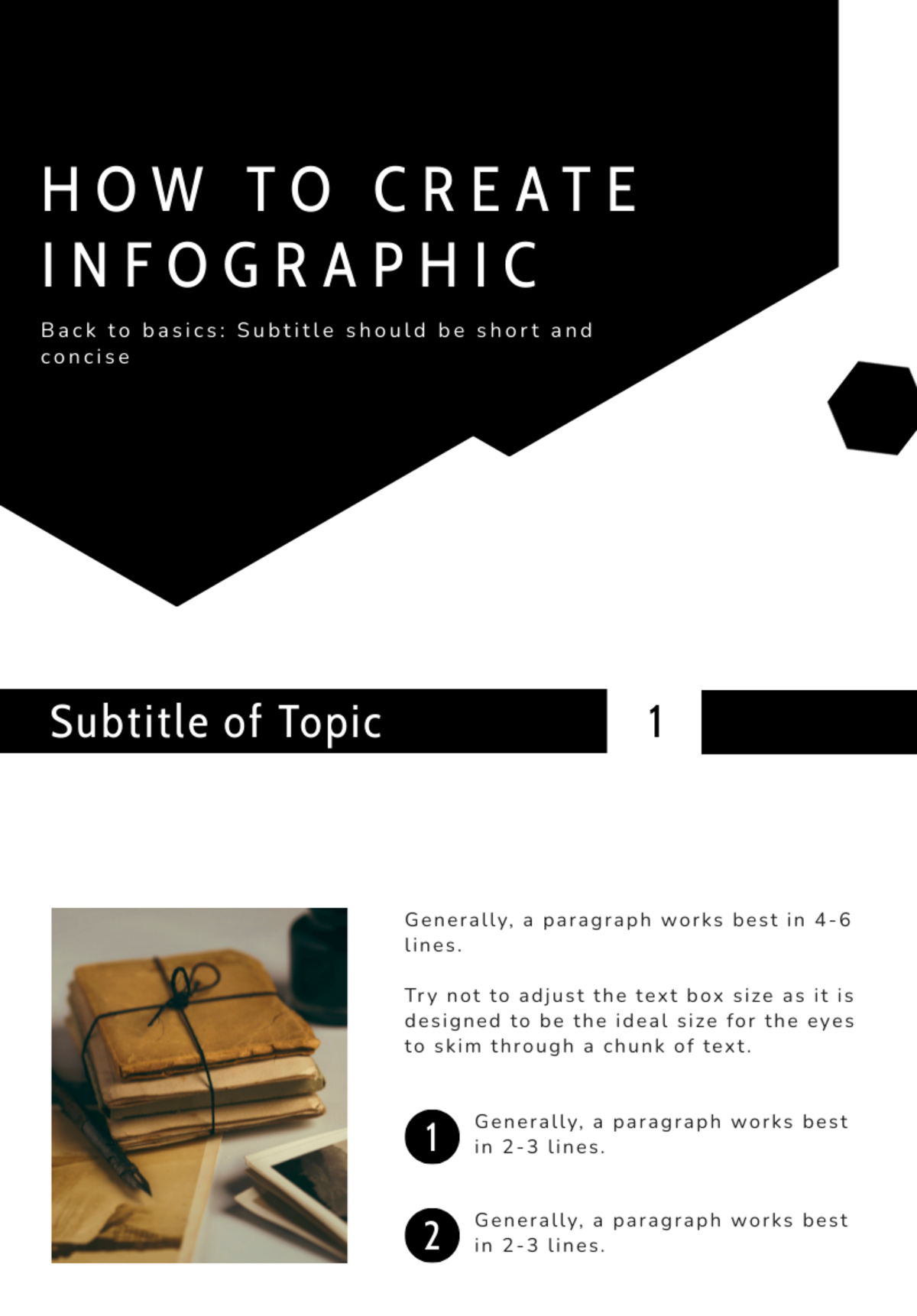
What is a Project Plan Template?
A project plan template is basically a pre-designed framework that project managers use to create a detailed plan for a project from start to finish. A simple project plan template provides a structured format that you can easily follow to set objectives, define tasks, schedule timelines, allocate resources, and other tasks involved in project and portfolio management. The template gives you a starting point and serves as a guide to make sure you have everything covered to successfully complete your project. Some project templates can also be used for project management, progress tracking, and reporting throughout the project life cycle.
Why are project templates important? Because project plans are crucial to your project’s success and templates provide the foundation for them. Think of these templates as rough sketches of your roadmap. They lay the groundwork for your project plan and help you detail every step of your project from inception to completion.
Why use a project plan template? The top-of-mind answer would be time efficiency. With their preset formats, all you’d need to do is edit the data, and you’re all set. Aside from saving you precious work hours, templates also provide the following benefits:
Alignment. Project plan templates help ensure that planning remains aligned with your strategic goals. They also help ensure that the entire team is in sync with the project objectives and timeline.
Standardization. Templates maintain consistency across teams. It ensures everyone involved shares the same information, which can be crucial for decision-making.
Accuracy. The structure of templates minimizes the likelihood of errors and omissions of important information. They reduce inaccuracies in project plans that might lead to costly mistakes.
Risk Management. Some templates include sections for identifying risks. This helps you lay proactive measures to mitigate such risks and minimize their impact on the project’s success.
Documentation. With sections for task assignments and schedules, templates establish a record of project specifics and the people responsible for certain roles
Key Elements of an Effective Project Plan Template
Project plan templates are diverse. There’s no single template that’s best for everyone. The nature and size of your project would determine which one is ideal for your needs. Still, there are key elements that every template should have for them to be effective in creating a well-designed project plan.
Objectives and Scope
What does the project aim to achieve? Within what boundaries will you operate? By having a clear definition of the objectives and scope, you set expectations and provide direction for the team. Clearly defined goals also prevent scope creep, mitigate risks, and prevent over/under allocation of resources. Most importantly, they set a consistent guide for decision-making throughout the project.
Timeline and Milestones
How long is the project expected to take? When is the deadline for the deliverables? The project timeline should be established before the project begins. If the project is complex, there should be milestones that serve as checkpoints to monitor progress and identify issues that might affect the next phases. By outlining the key stages of your project, you can create a structured roadmap that keeps you on track and within deadlines. It also enables you to immediately take corrective actions when there are schedule deviations.
Tasks and Responsibilities
What tasks does the project entail? Who is responsible for each of the tasks? The efficiency of project execution lies heavily on the accountability of the people involved. When there is clear ownership of responsibilities, team members become more committed to their roles and tend to perform better.
Assigning tasks beforehand also prevents duplication of efforts, misunderstandings, and other issues. Ultimately, clear definition of roles lead to smooth implementation, efficient collaboration, and project success.
Budget and Resources
What is the total budget for the project? How will the budget be allocated? How will expenses be tracked? A detailed resource allocation can prevent wastage and losses. It helps identify which expenses are necessary and ensures that the project has ample resources until its completion. With better financial control and resource utilization, projects can be finished within scope and set timelines.
Keep in mind that a project plan must include both a general overview and a detailed description of all its phases. It starts with a high-level project summary that defines the objectives, scope, key stakeholders, and project approach. It should also discuss the specifics of project execution, including the sequence of tasks, resources, dependencies, and key roles. All these elements must be in the project plan template for it to be effective.

How to Customize a Project Plan Template
Once you find a template that’s suitable for your project, adjust it according to your needs. First, identify your unique project requirements. Then, modify the template’s sections and add relevant details. Follow the tips below for effective project plan customization:
Clearly state your project objectives. Briefly describe factors like project scope, goals, stakeholders, timeline, budget, and resources to provide a summary of your project plan.
Review the template’s sections. Identify which parts are relevant to your project.
Modify the sections to align with your project requirements. Adjust headings, add or remove subsections, or rephrase content to better fit your project’s context.
Add pertinent details and information. Include project objectives, scope statements, deliverables, milestones, tasks, timelines, resource allocations, and any other relevant information.
Tailor the formatting and design elements to match your preferences and branding. This may include changing fonts, colors, styles, and layout to create a cohesive and visually appealing document
Once you’ve customized the project plan template Seek feedback from other team members or other stakeholders. Address feedback or suggestions for improvement.
Your project template isn’t only useful during the planning stage. Keep it updated throughout the project lifecycle to maximize its use. As the project progresses, revisit the plan regularly to make adjustments, incorporate new information, and track changes.
However, avoid making unnecessary changes. Over-customizing templates may create additional complexities that make your project plan ineffective and irrelevant. Too many iterations may also veer your project away from its set objectives.
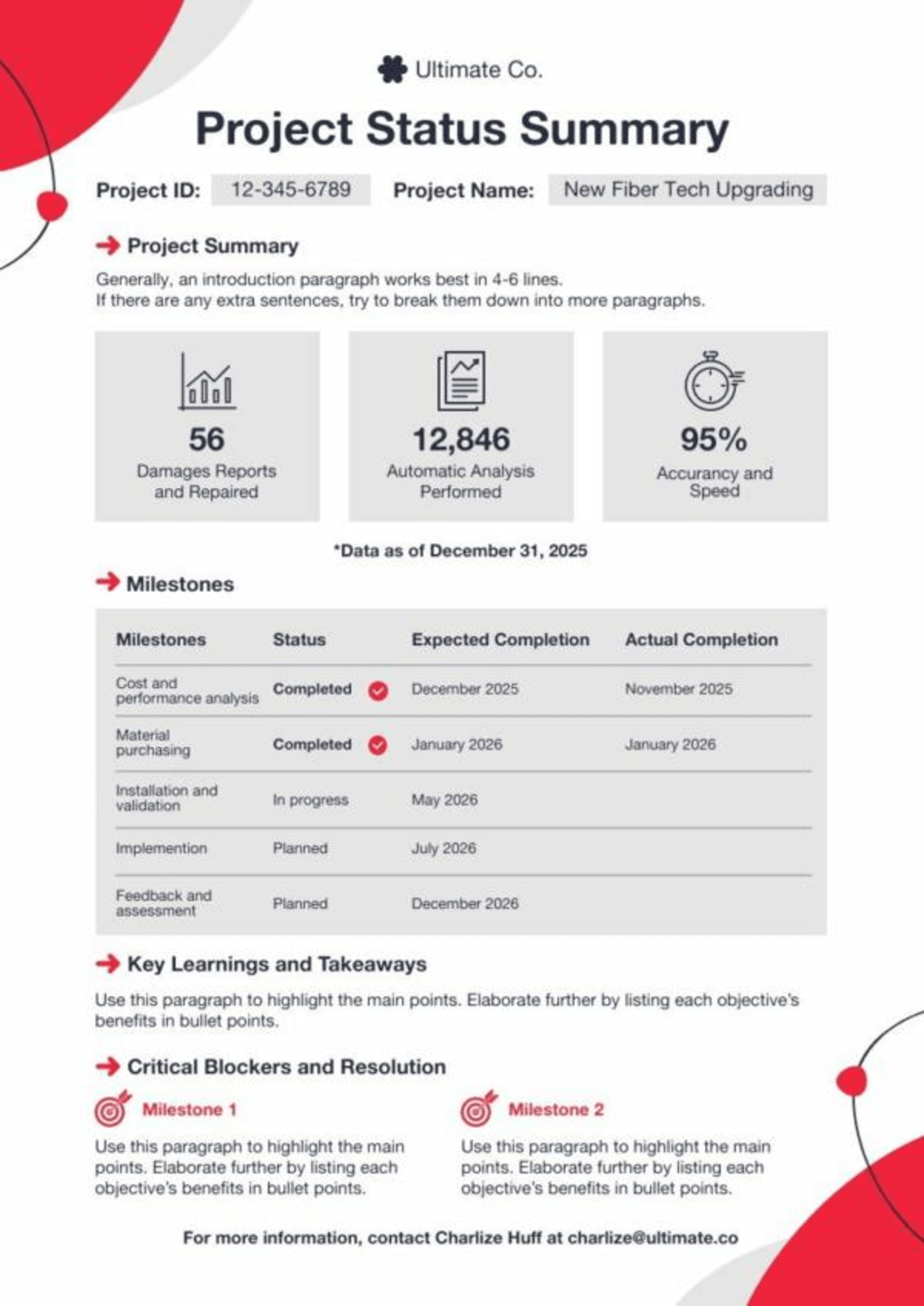
Best Practices for Using Project Plan Templates
Aside from regularly updating your project templates, here are three more things you can do to maximize their effectiveness and impact on the success of the project.
Get team and stakeholder buy-in.
Get everyone on board in choosing the template and creating the project plan. The support of your team members and the approval of key stakeholders hold the key that starts the ignition and gets you on the way to successful project implementation. Having everyone share a sense of ownership of the project keeps motivation high and collaboration fluid.
Use the plan to communicate and collaborate.
Leverage the project plan as a central communication tool to keep everyone informed and aligned throughout the project lifecycle. Share the plan with team members and stakeholders so everyone understands their roles, responsibilities, and the project’s overall direction.
Integrate with other project management tools.
Make project coordination more efficient by using project plan tools that integrate with other project management systems. Choose project templates that can be used and shared on different platforms.
When to Use Project Planning Software vs Templates
Project planning templates are simple and easy to use. They’re great for small projects or as a starting point for developing a more detailed project plan. However, they do have their limitations.
The generic and inflexible designs of templates may not be suitable for some projects, especially complex large-scale initiatives. While they can be tailored, extensive customization might be too time-consuming. Relying solely on a template may also cause you to overlook critical elements or dependencies unique to your problem.
For complex projects, project planning software may be more effective as it enables you to manage the entire project in one interface. They offer advanced functionalities that can help with agile and scalable planning and management. 65% of project managers also say that using software impacts the timely completion of projects.
|
Template |
Software |
|
Static framework with rudimentary charts |
Dynamic platform with interactive charts and feature |
|
Limited customization options |
High level of customization |
|
No real-time collaboration feature No document-sharing capabilities Relies on external communication tools |
Real-time collaboration among team members Centralized storage for faster data sharing Built-in communication channels |
|
No integration capabilities |
Seamless integration with other business tools and platforms |
|
Free or Minimal Cost |
Subscription-based pricing with varying tiers and features |
Now, how do you determine which approach is the right for your team? Well, consider the nature, size, and complexity of your project. Templates may suffice for small projects, but dedicated software may be required for large ones. Two things you can do to aid your decision-making process are:
Evaluate your team’s technical expertise and needs. If your team requires solutions with advanced features, start scouting for robust software. If they’re wary of using unfamiliar software, templates would still provide the structure they need for efficient planning.
Assess your budget and resources. While templates may be more cost-effective initially, advanced software can provide long-term benefits in terms of efficiency, productivity, and project success. If you have enough funds, investing in software could be worthwhile.
If you do choose to invest in project planning software, there are many options that cater to different needs and preferences. Some popular options include Microsoft Project, Asana, Trello, and Smartsheet.
Choose Project Templates That Align with Your Goals
The importance of project plans in keeping projects on schedule and within budget cannot be underscored further. They increase the likelihood of project success by establishing clear objectives, defining scope, setting timelines, allocating resources (manpower, financial, material, etc.), and enhancing collaboration among many other project management tasks.
Project templates aids you in achieving this. By providing a structured framework, templates let you streamline project plans, making project management easier. They also ensure consistency and clarity in project documentation, time efficiency, risk management, and team collaboration.
To make the most of project templates, choose ones that can be customized to align with your project’s specific requirements. Look for robust templates such as those in Piktochart. These templates allow you to use digital tools to create a project plan tailored to your goals.
To start using project plan templates effectively, consider signing up for Piktochart. Through its user-friendly platform, Piktochart equips you with templates to help you get every project on track. Building your project can be stressful, so get all the help you need.



